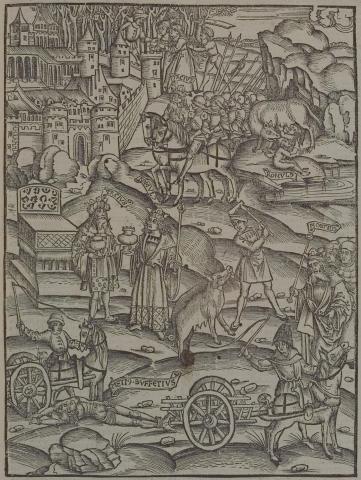Annotations
This image portrays a portion of what is illustrated on the shield that Vulcan has made for Aeneas. In the upper right, Romulus and Remus are nursed by a wolf in a cave by the river (630-4). In the upper middle, two Roman men take two Sabine women into the city by force, and the Sabine king Tatius [Tacius], leads an armed cavalry toward the city (635-8). Below the city, on the left, Tatius and Romulus stand before the altar of Jupiter holding vessels, while an attendant sacrifices a sow, to solemnize the treaty between them (639-41). At the bottom of the image, Mettus Fufetius [Metius Suffetius], is about to be pulled apart by two chariots moving at top speed in opposite directions (642-4). Tullus Hostilius [Mostilius] looks on, though not mentioned specifically by Vergil. It is a bit disappointing that Brant's illustrator did not attempt to fit more scenes in the image, and that he did not depict anything from the most prominent scene, the Battle of Actium (675-713). (Katy Purington)
Woodcut illustration from the “Strasbourg Vergil,” edited by Sebastian Brant: Publii Virgilii Maronis Opera cum quinque vulgatis commentariis expolitissimisque figuris atque imaginibus nuper per Sebastianum Brant superadditis (Strasbourg: Johannis Grieninger, 1502), fol. 326r, executed by an anonymous engraver under the direction of Brant.


Sebastian Brant (1458-1521) was a humanist scholar of many competencies. Trained in classics and law at the University of Basel, Brant later lectured in jurisprudence there and practiced law in his native city of Strasbourg. While his satirical poem Das Narrenschiff won him considerable standing as a writer, his role in the transmission of Virgil to the Renaissance was at least as important. In 1502 he and Strasbourg printer Johannes Grüninger produced a major edition of Virgil’s works, along with Donatus’ Life and the commentaries of Servius, Landino, and Calderini, with more than two hundred woodcut illustrations. (Annabel Patterson)